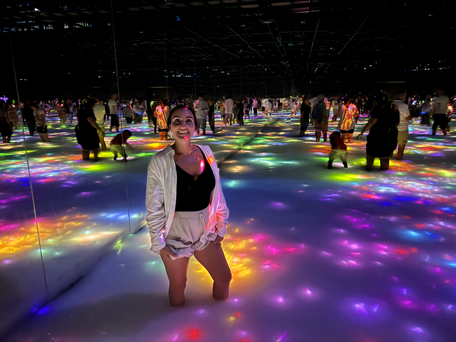Japan Part 1: City Highs and Skyscraper Skies
- Gabrielle Samad
- Nov 26, 2024
- 6 min read
November 2024
Konichiwa!
There is so much to say about our time in Japan that this post will be divided into two parts so I can get into all the nitty gritties.
Part 1: the cities, the hustle, the food and culture
Part 2: the nature, the quiet, the mossy green and spiritual
Part 1, here we go!
Taking a short flight from Korea, we arrived in Japan with our eyes wide and our chopsticks ready…. to hit the conveyor belt sushi with full force.
And hit the sushi we did….in the restaurants, the markets, train stations, 7/11s, convenient stores and basically all locations that sushi could be found, Gabby-San and Gabey-San were there. Wracking up those colorful plates, no shame, no gain, we definitely made a dent in the daily catch.
Just as we imagined, Japan was very technologically advanced, although surprising enough, we found Korea to be much more efficient and straightforward for travelers. The transportation systems in Japan, for example, was very confusing to navigate. On many occasions we roamed the station, up and down, trying to find our next train that was somehow connected by a completely different train line to the previous train, only to discover we had to “reserve” our seats in advance….ooofff! My head hurts just reliving it. With our turtle shell backpacks full to the brim, we ran back to the ticket booth to reserve seats within minutes before the train departed. Was not our finest, but once we finally got on the speed trains, it was pretty amazing getting from A to Z in a flash (with slivers of my sanity still in tact).

On another note, the train stations were a world within themselves, with underground shopping malls, banks and food courts creating a robust underground network. In the Tokyo train station there is literally an underground “ramen street” where you can find rows of ramen restaurants one after another. Somehow, Gabe has acquired this “spidey” food sniffing six sense, where no mater where we go, he sniffs out the best place out of a row of 100 restaurants. I am the lucky beneficiary and had one of the best ramens of my life in Tokyo train station! Arigatō, Gabey-san.
Still, Japan was more advanced in other ways, my most notable observation being their version of the smart toilet (yes, I’m back on the toilet talk 😂). Japan’s smart toilet was FAR beyond the times of the Korean 1.0 version. Every. single. public toilet we visited, and I mean, every toilet, even in the most basic of places, was a smart toilet and the best feature was the personal music feature where you could play nature sounds and rain noises to mask the sound of your business. Japan smart toilet 2.0 for the win!
Just wait until we get to India…. we will have to get off our golden toilet throne 😂

As part of my immersive travel process (this is what I am calling it these days!), my book of choice for Japan was “Memoirs of a Geisha” and I also watched the series “Panchiko”. Both connected me deeper to the history of Japan, pre and post war, and also helped me understand some cultural nuances. As I walked certain streets and passed traditional teahouses, temples and shrines, I felt more connected to what I was seeing and experiencing because of the book's context.
It was especially special to visit two prominent Geisha districts in Kanazawa and Kyoto. I learnt so much about the unique, beautiful and anguished life of a Geisha; the schooling they must undergo since a young age and level of pristine training required to reach a level of perfection. I walked through the Geisha corners, through paths that many women had walked before me and imagined what it was like to dress in a kimono and full make-up to perfection day in and out. To learn how to be agreeable, to charm, to hold mystery and poise, all for the purpose of entertaining men. A geisha’s life, success and livelihood all stemmed from their popularity among wealthy men. To be a geisha is to be judged as a moving work of art and the Geisha is the artist of their craft. From over 80,000 practicing geishas in the 1920s, there are only around 1,000 practicing geishas in Japan today. Truly remarkable to learn and see a glimpse of this once big piece of Japanese culture, there is something magical to the traditional art, beauty and order.
From the busting cities of Tokyo and Osaka, to the smaller cities of Kamakura, Kanazawa and Kyoto, we found many other amusing aspects of Japan:
There are no public trash bins in the cities. You must carry any trash that you have accumulated throughout the day until you find a private bin. Despite no public bins, the cities were super clean! Really impressive.
2. Animal cafes: in Tokyo we found streets lined with animal cafes where you pay to enter, have a coffee or cake and play with baby animals. They had cafes for cats, dogs, piglets, hedgehogs, guinea pigs and even OTTERS 🦦. We didn’t enter but had a peak through the windows. I personally didn’t love the vibe.
3. People are not pushy and don’t try to sell you anything. We loved this! It was so fun exploring without feeling pressure to buy something or being followed by a storekeeper. They have a “take it or leave it” mentality that was really refreshing.
4. Ryokan Culture: to get a true feel of traditional Japanese culture and how they used to live, lodges today offer the “Ryokan experience”. These are slightly more expensive accommodations designed in the old Japanese traditional style with tatami mats lining the floors, all furniture low to the ground and traditional style Japanese mattresses placed directly on the floor. Ryokans often host traditional tea ceremonies, a sacred perfected practice, have onsen spring hot baths, and small Japanese zen gardens so you get the full Japanese experience.
Ryokans book up very quickly so we had to book our stay months in advance and I was so excited for our one night Ryokan adventure! Sadly, our Ryokan turned out to be less than fabulous and we spent $300 to sleep on a 3 inch mattress on the floor with no windows 😂, authentic? possibly..... definitely do your Ryokan research before booking. On the bright side, the one saving grace of the Ryokan was a quaint Japanese garden in the back with a beautiful coy fish pond. One of the biggest coy fish in the pond was a mesmerizing gold color that I watched swim for what felt like hours. Was the golden fish worth the $300? Well, gold is expensive these days.
5. Japanese KNOW how to cook, and not only Japanese food. They excelled in all of the cuisines we tried and honestly, we regularly hit up the supermarkets for ready-made food for late night snacks. The supermarket food was bomb, with all pre-packaged fresh yakisoba, sushi, dumplings and cheesy bread galore.
6. Walking your dog in Japan is taken to a whole new level. Instead of walking your dog on a leash to get the daily exercise, we constantly saw dogs being pushed in baby strollers. Countless times I tried to take a sneaky peak into a passerby’s stroller to see their newborn, only to find 2-3 dogs snuggled, getting wheeled around in luxury. Not a bad life for a pup.

7. TeamLab’s interactive digital art museum is a MUST GO for any visit to Japan. Wow, this experience truly felt like I won Willy Wonka’s golden ticket and I was one of the lucky explorers into Willy Wonka’s magic factory. The museum was an immersive experience of twists and turns, each room more astonishing than the next, with different visuals, sound, lights, music and colors, you feel completely part of the experience. With each exhibit I felt I was entering another world, another mind frame of beauty, imagination and discovery. I had a glimmer of what it felt like to be a wide-eyed curious child again, and it felt amazing.
I could clearly go on and on, but I will save the rest for Japan part 2, “nature edition.”
Arigatō for getting this far and following us on the journey!
































































Comentários